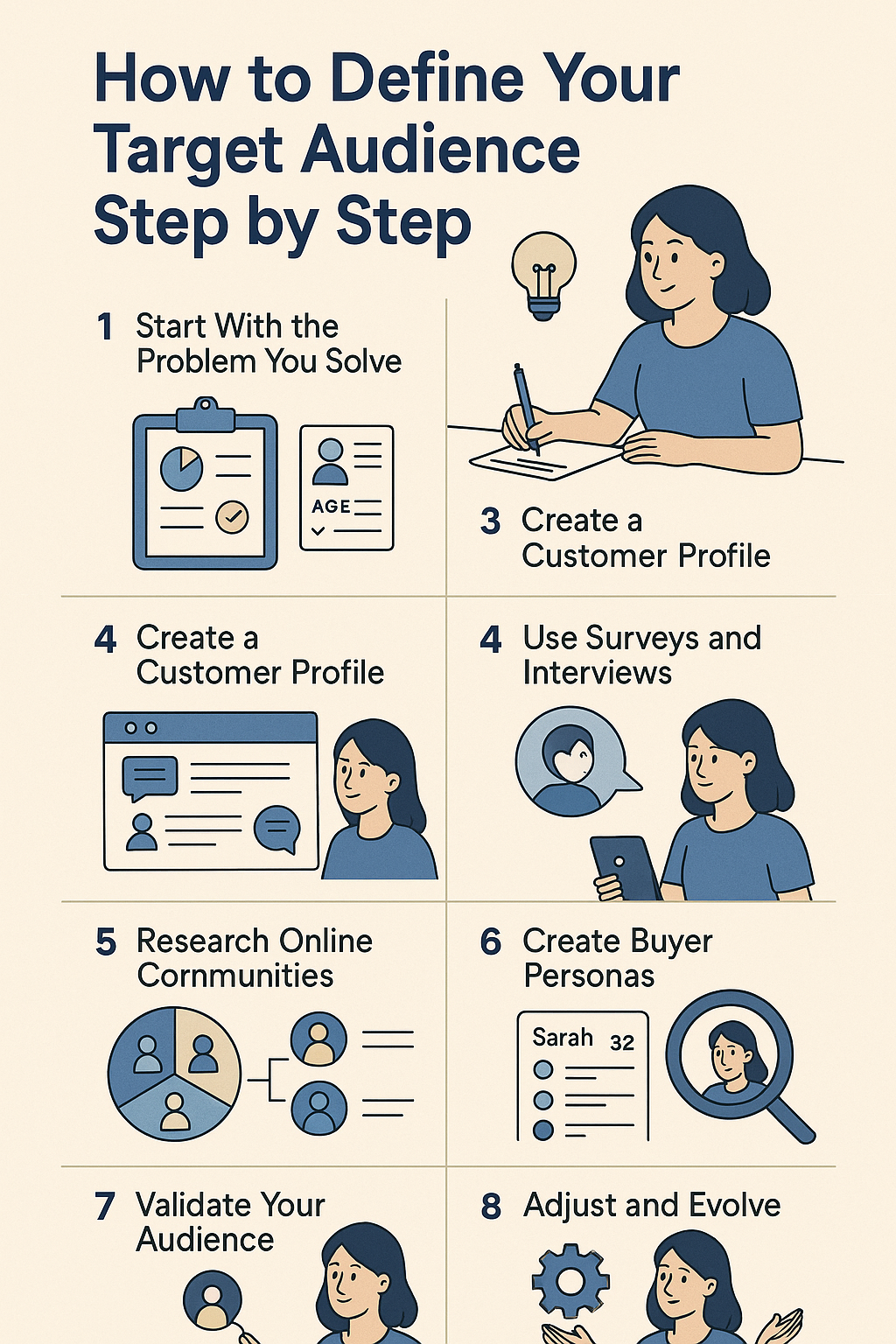Defining your target audience is one of the most important steps in building a successful business. Without knowing who your ideal customer is, you risk wasting time and money on marketing that doesn’t work. When you clearly identify your target audience, you can create better products, stronger messages, and more effective strategies that connect directly with the right people.
This article will walk you through a step-by-step process to define your target audience with precision.
Why Your Target Audience Matters
Your target audience is the specific group of people most likely to buy your product or service. When you understand them well, you can:
- Speak their language in your marketing.
- Solve their exact problems.
- Build stronger loyalty and trust.
- Use resources more efficiently.
Instead of trying to please everyone, focus on the people who need and value what you offer.
Step 1: Start With the Problem You Solve
Every business exists to solve a problem. Your target audience is made up of the people who experience that problem.
Ask yourself:
- What specific problem does my product or service solve?
- Who feels this problem the most?
- How urgent is this problem for them?
Example: If you sell eco-friendly cleaning products, your target audience could be environmentally conscious households that want safer alternatives for their families.
Step 2: Analyze Your Current Customers (If Any)
If you already have customers, analyze who they are. Patterns in your current buyers can reveal your true target audience.
Look at:
- Demographics: age, gender, location, income.
- Buying behavior: how often they purchase, what they prefer.
- Feedback: what they say about your product.
Even with a small sample, you can identify trends that guide your strategy.
Step 3: Create a Customer Profile
A customer profile is a detailed description of your ideal buyer.
Include:
- Demographics: age, gender, education, income, location.
- Psychographics: interests, values, lifestyle.
- Behavioral traits: buying habits, preferred communication channels.
Example: “Our target audience is women aged 25–40, living in urban areas, with mid-level income, who care about health and sustainability. They often shop online and look for eco-friendly products.”
Step 4: Use Surveys and Interviews
Talking directly to potential customers provides powerful insights.
Questions to ask:
- What is your biggest challenge related to [your product category]?
- How do you currently solve this problem?
- Where do you usually look for solutions?
- What would make you switch to a new product or service?
The answers help refine your understanding of their needs and desires.
Step 5: Research Online Communities
Many people discuss their challenges in online spaces. Forums, social media groups, and review sites are excellent places to learn more.
- Facebook groups: See what questions people ask.
- Reddit threads: Look at discussions about similar products.
- Amazon reviews: Read what customers love and hate about existing solutions.
This research shows what your target audience cares about most.
Step 6: Create Buyer Personas
A buyer persona is a fictional character that represents your ideal customer. It helps you visualize and “humanize” your audience.
Example Persona:
- Name: Sarah
- Age: 32
- Occupation: Marketing professional
- Goal: Wants to eat healthier without spending too much time cooking.
- Challenge: Busy lifestyle, limited time for meal prep.
Personas make it easier to create content and marketing campaigns that resonate.
Step 7: Segment Your Audience
Not all customers are the same, even within your target group. Segment them into smaller groups based on specific traits.
For example, if you sell fitness coaching:
- Segment 1: Young professionals looking for quick workouts.
- Segment 2: Parents who want family-friendly fitness routines.
- Segment 3: Retirees focusing on low-impact exercises.
This allows you to customize offers and messages for each segment.
Step 8: Validate Your Audience
Don’t assume you know your audience perfectly—test it. Use small campaigns to see how different groups respond.
Ways to validate:
- Run ads with different messaging and see which performs best.
- Offer free content and track who engages with it.
- Analyze website and social media analytics to identify patterns.
Validation ensures you’re targeting the right people before scaling up.
Step 9: Adjust and Evolve
Your target audience may change over time as your business grows or as market trends shift. Keep analyzing and updating your profiles.
Tips:
- Revisit customer data regularly.
- Adjust buyer personas based on new insights.
- Stay aware of changing industry trends.
Flexibility keeps your business relevant and connected to the right people.
Final Thoughts: Clarity Leads to Growth
Defining your target audience is not a one-time task—it’s an ongoing process. By clearly identifying who you serve, you can market more effectively, sell with confidence, and build stronger relationships with your customers.
Remember: when you try to sell to everyone, you sell to no one. Focus on your true audience, and your business will grow faster and more sustainably.
